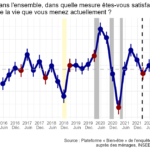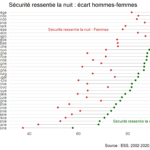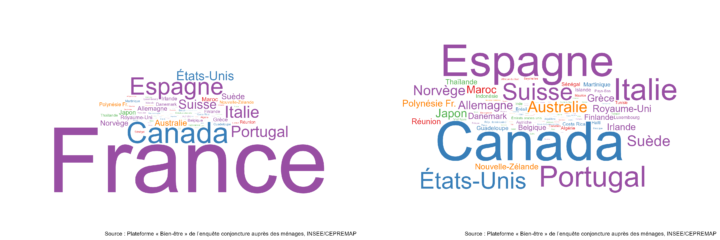
En ce début de printemps, nous sommes heureux de vous proposer trois Notes ainsi qu’un billet de blog. Outre notre point trimestriel sur la conjoncture, nous nous sommes penchés à l’occasion de la journée des droits des femmes sur le sentiment de sécurité en France. Nous vous proposons également de découvrir la première exploitation détaillée de notre question « Dans quel pays aimeriez-vous vivre » ?
Nous allons très prochainement annoncer la date de présentation de notre rapport annuel sur le Bien-être en France. Plus d’informations à venir très bientôt !
Observatoire
Le Bien-être des Français – Mars 2023

En mars 2023, notre enquête trimestrielle livre l’image d’une France inquiète de l’avenir du pays, aussi bien du futur proche des habitants que de celui des prochaines générations. Ce pessimisme accompagne la chute de l’indice de confiance des ménages de l’Insee, signe du retour de l’économie au premier plan des préoccupations des Français.
Mathieu Perona, « Le Bien-être des Français – Mars 2023 », Notes de l’Observatoire du bien-être (Paris: Cepremap, 5 avril 2023), https://www.cepremap.fr/2023/04/note-de-lobservatoire-du-bien-etre-n2023-07-le-bien-etre-des-francais-mars-2023/.
Journée des droits des femmes 2023 – Les Françaises se sentent-elles en sécurité ?

À l’occasion de la journée mondiale pour la défense des droits des femmes, nous sommes revenus sur l’écart genré qui existe en France sur le sentiment de sécurité la nuit dans son quartier. Présent depuis le début de notre enquête, cet écart ne diminue pas. Nous mettons en ouvre en évidence une dépendance croisée au revenu et au lieu de vie. Plus qu’ailleurs en Europe, l’écart entre hommes et femmes dépent du niveau de revenu, mais seulement dans les habitats denses. La ville est ainsi perçu comme particulièrement menaçantes par les femmes des ménages modestes.
Elizabeth Beasley, Corin Blanc, et Perona, « Journée des droits des femmes 2023 – Les Françaises se sentent-elles en sécurité ? », Notes de l’Observatoire du bien-être (Paris: Cepremap, 8 mars 2023), https://www.cepremap.fr/2023/03/note-de-lobservatoire-du-bien-etre-n2023-05-journee-des-droits-des-femmes-2023-les-francaises-se-sentent-elles-en-securite/
Vivre ailleurs ?
Depuis 2022, nous avons ajouté à notre tableau de bord une question inédite, de mandant dans quel pays les personnes interrogées aimeraient vivre, indépendamment des contingences matérielles. Malgré une question conçue pour orienter vers l’étranger, la préférence pour la France reste grande. Quant à l’ailleurs, il est marqué par une forme de proximité, qu’il s’agisse du Canada, qui partage pour partie notre langue, ou des pays voisins d’Europe du Sud.
Mathieu Perona, « Vivre ailleurs ? », Notes de l’Observatoire du bien-être (Paris: Cepremap, 27 mars 2023), https://www.cepremap.fr/2023/03/note-de-lobservatoire-du-bien-etre-n2023-06-vivre-ailleurs/.

Inégalités de santé ressentie
Suite à une publication britannique, nous nous sommes interrogés sur l’ampleur des inégalités de santé ressentie croisant les dimensions d’âge et de revenu, une question évidemment sensible dans le contexte d’un recul de l’âge de la retraite.
Les données Camme font apparaître un niveau élevé d’inégalité : les ménages du tiers inférieur de la distribution de revenu ont, entre 40 et 50 ans, le même niveau moyen de santé subjective que les ménages du tiers supérieur entre 70 et 75 ans.
Mathieu Perona, « Inégalités de santé ressentie », Billet, Carnet de l’Observatoire du Bien-être du CEPREMAP (blog), 24 mars 2023, https://obe.hypotheses.org/589.
Lu sur le web
Subjective Inequity Aversion: Unfair Inequality, Subjective Well-Being, and Preferences for Redistribution
Abstract: This paper argues that `inequity aversion’ can be understood as an emotional reaction to perceived injustice that arises from individuals’ comparisons of their own and others’ outcomes to a subjective fairness ideal. In particular, we assume that subjective perceptions of inequity and not objective deviations from equality are crucial to understanding how individuals react to inequality. The paper formalizes these insights by adapting the Fehr and Schmidt (1999) model of inequity aversion replacing the fairness frame of objective equality with subjectively perceived equity. We test this model using data from the European Social Survey 2018 analyzing the association between respondents’ perceived fairness of own, top, and bottom incomes with subjective well-being and preferences for redistribution. Results from spline regressions with country-fixed effects indicate that perceived injustice of own and top incomes is positively related to individuals’ subjective well-being. For the perceived injustice of bottom incomes, we find no substantive relationships with subjective well-being. Further analyses indicate a positive link between the perceived injustice of bottom and top incomes and preferences for redistribution. In sum, our results suggest that injustice perceived for oneself is connected to utility while perceived injustice of others is related to increased willingness to back redistributive policy proposals even if they are not in line with material self-interest.
Sandra Bohmann et Fabian Kalleitner, « Subjective Inequity Aversion: Unfair Inequality, Subjective Well-Being, and Preferences for Redistribution », SocArXiv (Center for Open Science, 23 janvier 2023), https://econpapers.repec.org/paper/osfsocarx/g8arw.htm.
Measuring well-being and lives worth living
Abstract: We study the measurement of well-being when individuals have heterogeneous preferences, including dierent conceptions of a life worth living. When individuals dier in the conception of a life worth living, the equivalent income can regard an individual whose life is not worth living as being better o than an individual whose life is worth living. In order to avoid this paradoxical result, we reexamine the ethical foundations of well-being measures in such a way as to take into account heterogeneity in the conception of a life worth living. We derive, from simple axioms, an alternative measure of well-being, which is an equivalent income net of the income threshold making lifetime neutral. That new well-being index always ranks an individual whose life is not worth living as worse-o than an individual with a life worth living.
Marc Fleurbaey et Gregory Ponthiere, « Measuring well-being and lives worth living », Post-Print (HAL, avril 2022), https://econpapers.repec.org/paper/haljournl/hal-03907520.htm.
Navigating the well-being effects of monetary policy:Evidence from the European Central Bank
Abstract: This paper assesses whether monetary policy announcements have an impact on households’ (subjective) well-being by analysing life satisfaction on the days before and after monetary surprises in Germany. To do so, we use individual-level information on life satisfaction from the German Socio-Economic Panel (SOEP) survey and identify the day on which each answer is submitted to the survey. We also exploit the Euro Area Monetary Policy event study Database (EA-MPD) to obtain daily-level information on European Central Bank (ECB) monetary surprises. Our results show that life satisfaction is significantly affected by monetary policy surprises: tightening surprises decrease life satisfaction, while easing surprises increase it.
Mehdi El Herradi et Aurelien Leroy, « Navigating the well-being effects of monetary policy:Evidence from the European Central Bank », Working Paper (HAL, 14 décembre 2022), https://econpapers.repec.org/paper/halwpaper/hal-03897994.htm.
Worldview defence and self-determination theory explain the return of racial voting: Evidence from the 2016 US election
Abstract: We use self-determination (SDT) and worldview defence theories (WDT) to explicate the psychological roots of identitarian voting in recent US, UK and EU elections. We test our theory using the 2016 US election as a case study, data from a representative sample of nearly half a million Americans, and a measure of racial animus derived from Google search data. We find that worry has a strong and significant positive association with Trump’s vote share, as predicted by WDT. However, this is reversed in counties with high levels of relatedness—one of the three basic psychological needs emphasised by SDT. The positive relationship between racial animus and Trump also loses significance once an interaction between racial animus and relatedness is introduced. These results imply that identitarianism is driven at least in part by a desire for in-group affiliation emerging out of worldview defence and unmet basic psychological needs.
Mark Fabian, Robert Breunig, et Jan-Emmanuel De Neve, « Worldview Defence and Self-Determination Theory Explain the Return of Racial Voting: Evidence from the 2016 US Election », European Journal of Social Psychology 53, no 1 (2023): 147‑66, https://doi.org/10.1002/ejsp.2894.
Parenthood and dynamics of life satisfaction in times of COVID-19
Abstract: We analyze data from the UK Household Longitudinal Study, including a pre-pandemic baseline and seven survey waves between May 2020 and September 2021. Fixed effects panel regression models are run over more than 11,000 individuals, distinguishing among women and men with young children (<5 years), older children (5-15 years), or no children in the household. We hypothesize that declines in life satisfaction during the first lockdown are sharper among parents, whose domestic demands increase, than among the childless. We develop competing hypotheses that parents might be resilient and have higher life satisfaction during the later phases of the pandemic (Adaptation Hypothesis) or that the pandemic stressors accumulate, leading to even lower satisfaction over time (Accumulation Hypothesis). The results only support the Accumulation Hypothesis among mothers. Whereas mothers fared comparatively well during the first lockdown, further pandemic stressors have seemingly exhausted their resilience, leading to stronger declines during the winter 2020/2021 lockdown. Among men with older children and without children, life satisfaction decreased during the first and subsequent lockdowns. Men with young children were the only group with almost unchanged life satisfaction throughout the pandemic.
Ansgar Hudde, Karsten Hank, et Marita Jacob, « Parenthood and Dynamics of Life Satisfaction in Times of COVID-19 », The British Journal of Sociology, 1 février 2023, https://doi.org/10.1111/1468-4446.13003.
Black-White Differences in Parental Happiness
Abstract: Lower levels of happiness among Blacks compared with Whites are well documented, as are lower levels of happiness among parents compared with nonparents. Yet it remains unclear whether the parenting happiness gap is larger among Blacks compared with Whites. Drawing on the General Social Survey (2010–2018), the authors investigate this question. The authors find that White mothers reported less happiness compared with their White female nonparent counterparts, but contrary to research highlighting the profound challenges of parenting for Black women, a parental happiness gap among Black women was not observed. Among Black men, parents reported a much higher probability of being very happy than their nonparent counterparts, whereas White fathers’ happiness was no different from that of their male counterparts without children. These findings are discussed in view of stereotypes about Black mothers and fathers, their resilience to stressors such as racism and discrimination, and emerging research on the salience of fatherhood for Black men.
Jennifer Augustine et Mia Brantley, « Black-White Differences in Parental Happiness », Socius 9 (1 janvier 2023): 23780231231153616, https://doi.org/10.1177/23780231231153617.
Income and emotional well-being: A conflict resolved
Abstract: Do larger incomes make people happier? Two authors of the present paper have published contradictory answers. Using dichotomous questions about the preceding day, [Kahneman and Deaton, Proc. Natl. Acad. Sci. U.S.A. 107, 16489–16493 (2010)] reported a flattening pattern: happiness increased steadily with log(income) up to a threshold and then plateaued. Using experience sampling with a continuous scale, [Killingsworth, Proc. Natl. Acad. Sci. U.S.A. 118, e2016976118 (2021)] reported a linear-log pattern in which average happiness rose consistently with log(income). We engaged in an adversarial collaboration to search for a coherent interpretation of both studies. A reanalysis of Killingsworth’s experienced sampling data confirmed the flattening pattern only for the least happy people. Happiness increases steadily with log(income) among happier people, and even accelerates in the happiest group. Complementary nonlinearities contribute to the overall linear-log relationship. We then explain why Kahneman and Deaton overstated the flattening pattern and why Killingsworth failed to find it. We suggest that Kahneman and Deaton might have reached the correct conclusion if they had described their results in terms of unhappiness rather than happiness; their measures could not discriminate among degrees of happiness because of a ceiling effect. The authors of both studies failed to anticipate that increased income is associated with systematic changes in the shape of the happiness distribution. The mislabeling of the dependent variable and the incorrect assumption of homogeneity were consequences of practices that are standard in social science but should be questioned more often. We flag the benefits of adversarial collaboration.
Matthew A. Killingsworth, Daniel Kahneman, et Barbara Mellers, « Income and emotional well-being: A conflict resolved », Proceedings of the National Academy of Sciences 120, no 10 (7 mars 2023): e2208661120, https://doi.org/10.1073/pnas.2208661120.
Explaining Happiness Trends in Europe
Abstract: In Europe differences among countries in the overall change in happiness since the early 1980s have been due chiefly to the generosity of welfare state programs— increasing happiness going with increasing generosity and declining happiness with declining generosity. This is the principal conclusion from a time series study of ten Northern, Western, and Southern European countries with the requisite data. In the present study cross-section analysis of recent data gives a misleading impression that economic growth, social capital, and / or quality of the environment are driving happiness trends, but in the long-term time-series data these variables have no relation to happiness. Significance: Over the past five decades happiness has emerged as a subject of social science research and a potential goal of public policy. But how can a country’s happiness be increased? On this, there is a conflict between a number of policy alternatives – promote economic growth, increase social capital, improve the environment, expand welfare state programs. Each of these has point-of-time (cross-section) evidence supporting its claim, but there are very few long-term time-series studies. This article presents newly available time-series evidence that supports the importance of welfare state policies.
Richard A. Easterlin et Kelsey O’Connor, « Explaining Happiness Trends in Europe », IZA Discussion Paper (Institute of Labor Economics (IZA), janvier 2023), https://econpapers.repec.org/paper/izaizadps/dp15904.htm
A multiverse analysis of the associations between internet use and well-being
Abstract: Internet technologies’ and platforms’ potential psychological consequences remain debated. While these technologies have spurred new forms of commerce, education, and leisure, many are worried that they might negatively affect individuals by, for example, displacing time spent on other healthy activities. Relevant findings to date have been inconclusive and of limited geographic and demographic scope. We examined whether having (mobile) internet access or actively using the internet predicted eight well-being outcomes from 2006 to 2021 among 2,414,294 individuals across 168 countries. We first queried the extent to which well-being varied as a function of internet connectivity. Then, we examined these associations’ robustness in a multiverse of 33,792 analysis specifications. 84.9% of these resulted in positive and statistically significant associations between internet connectivity and well-being. These results indicate that internet access and use predict well-being positively and independently from a set of plausible alternatives.
Matti Vuorre et Andrew K. Przybylski, « A Multiverse Analysis of the Associations between Internet Use and Well-Being » (PsyArXiv, 27 mars 2023), https://doi.org/10.31234/osf.io/jp5nd.